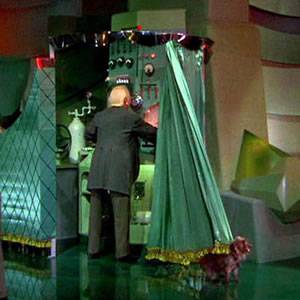Pay No Attention To The Essential Plot Device Behind The Curtain
 So while writing this blog post, I was deep in the middle of a class by Kris Kennedy on backstory. (Which was excellent BTW, so if you ever see her teaching that class anywhere, run to register!)
So while writing this blog post, I was deep in the middle of a class by Kris Kennedy on backstory. (Which was excellent BTW, so if you ever see her teaching that class anywhere, run to register!)
If you don’t know what backstory is, it’s the part of your book you’re not supposed to put on the page. It’s the contents of that dreaded info dump we know we shouldn’t let anywhere near our prose unless it’s in drips and drabs throughout our novel. And it’s also the wizard hiding behind the curtains in Oz, directing the story but taking no action of his own.
Kris’s class brought home how important backstory is. One exercise she gave us was to write a scene that would never go into our book. We could hint at it, allude to it, even let it affect our characters daily, but we could never show our readers or tell them what happened in that scene. That one scene was important in a way the rest of our character’s life until the book, was not. It was the singular event that gave us the Wound.
Michael Hauge uses the terminology the Wound to denote a single event that changes the life, beliefs, and psychology of a character. This wound event impacts all the events that follow it. This one event is the place where something happened to your character to make them believe an erroneous fact which the arc of your novel will correct. It’s the event that “broke” them.
And a wound doesn’t have to be traumatic. It has to be earth-shattering… or at least able to shake what your character perceives is firm ground beneath them. An example of this would be your protagonist finding out a role model is a drug dealer. It could lead your character to the opinion that no one is what they seem, or every person is weak and self-serving. Another example might have a protagonist live through a house fire, which could lead to a fear of fire, being loathe to buy material goods that can vanish in a puff of smoke, or obsessively checking the oven and the electrical wiring for short circuits. These wounds lead to the character thinking something erroneous about themselves. In the fire’s case, a hero might decide it’s better not to get attached to things and people or bad things inevitably happen to them. In the role model’s case, a heroine decides everyone is just out for themselves, or it’s stupid to work hard when the world rewards cheaters.
As we’re writing romance, both your characters must complete an arc and if they both stem from a wound, even better. But to go one step further, to tighten your prose, make it the same event! How much more conflict would your story have if one character set the fire that led to their house burning down and their romantic partner lost a father fighting that same house fire? And in the other example, what if your protagonist found out their role model was selling drugs and their romantic lead found out the role model sold the drugs that led to their brother’s initial substance abuse problems? Conflict everywhere!
 Likewise, you can use the same wound from different sources and your two romantic leads will have very different reactions to it. For example, one might survive a house fire and lose a beloved sibling, leading them to be clingy around those they love. Whereas their partner may survive a fire but lose a sibling and believe the wrong child survived. These very different reactions will color every single decision they make in your book. For example, one might refuse to go to college and leave their home and family but the other might join the volunteer firefighters to justify their survival. Same event, different reactions, both broken, and both allowing one event to dictate their day-to-day existence.
Likewise, you can use the same wound from different sources and your two romantic leads will have very different reactions to it. For example, one might survive a house fire and lose a beloved sibling, leading them to be clingy around those they love. Whereas their partner may survive a fire but lose a sibling and believe the wrong child survived. These very different reactions will color every single decision they make in your book. For example, one might refuse to go to college and leave their home and family but the other might join the volunteer firefighters to justify their survival. Same event, different reactions, both broken, and both allowing one event to dictate their day-to-day existence.
And that’s what this one momentous event is for your story. Every single scene of your novel needs to have one decision, one reminder, or one memory colored by this event — even if it’s an emotion or a single body language tell. The emotional wound must break your character from their ability to live a fulfilling life. It’s not a solvable mystery (although readers will treat it that way if you’re doing your job and NOT putting it in the story) nor is it a single event that just occurred in your character’s past. It is THE EVENT, the one that shaped them, makes all their decisions for them, leads their life, and the one they must correct to become whole and able to love another person whole-heartedly.
So go write that scene… and then let it direct your story from behind the curtain.
